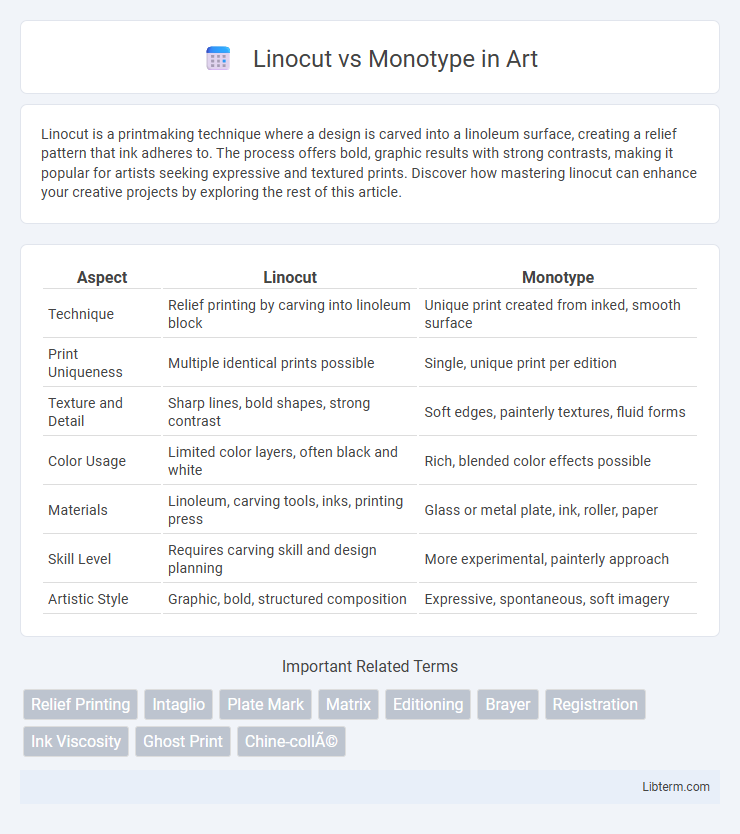Linocut is a printmaking technique where a design is carved into a linoleum surface, creating a relief pattern that ink adheres to. The process offers bold, graphic results with strong contrasts, making it popular for artists seeking expressive and textured prints. Discover how mastering linocut can enhance your creative projects by exploring the rest of this article.
Table of Comparison
| Aspect | Linocut | Monotype |
|---|---|---|
| Technique | Relief printing by carving into linoleum block | Unique print created from inked, smooth surface |
| Print Uniqueness | Multiple identical prints possible | Single, unique print per edition |
| Texture and Detail | Sharp lines, bold shapes, strong contrast | Soft edges, painterly textures, fluid forms |
| Color Usage | Limited color layers, often black and white | Rich, blended color effects possible |
| Materials | Linoleum, carving tools, inks, printing press | Glass or metal plate, ink, roller, paper |
| Skill Level | Requires carving skill and design planning | More experimental, painterly approach |
| Artistic Style | Graphic, bold, structured composition | Expressive, spontaneous, soft imagery |
Introduction to Linocut and Monotype
Linocut is a relief printing technique where an image is carved into a linoleum surface, allowing raised areas to be inked and pressed onto paper, producing bold and textured prints. Monotype involves creating a unique, one-of-a-kind print by painting or drawing on a smooth plate, which is then pressed onto paper, resulting in unpredictable and expressive marks. Both methods offer distinct artistic qualities, with linocut emphasizing precision and repeatability, while monotype focuses on spontaneity and singular impressions.
Defining Linocut: Techniques and Tools
Linocut is a relief printmaking technique that involves carving a design into a linoleum sheet using gouges and cutting tools to create raised areas that receive ink. The tools typically include V-shaped and U-shaped gouges, along with bench hooks and brayers for inking the surface evenly. This method allows for bold, graphic images with distinct textures and sharp contrasts, differing from monotype's painterly and singular prints.
Understanding Monotype: Process and Approach
Monotype is a unique printmaking technique that produces a single, original print by painting or drawing directly onto a smooth surface such as glass or metal, which is then pressed onto paper to transfer the image. Unlike linocut, which involves carving a design into a linoleum block to create multiple prints, monotype emphasizes spontaneity and the unpredictability of textures and tones created during the transfer process. This approach allows artists to explore fluid, painterly effects that blend drawing and printmaking, making each monotype a one-of-a-kind artwork.
Key Differences Between Linocut and Monotype
Linocut involves carving a design into a linoleum block, allowing for multiple prints with consistent detail, while monotype creates a single, unique print by painting or drawing on a smooth surface before transferring it to paper. Linocut prints exhibit bold lines and textures due to the carved relief, whereas monotype prints feature softer, more painterly qualities with varied textures and tonal ranges. The reproducibility of linocut contrasts with the singular, spontaneous nature of monotype, highlighting distinct artistic techniques and visual effects.
Artistic Style and Visual Outcomes
Linocut produces bold, graphic images characterized by high contrast and sharp lines created through carving into linoleum blocks, resulting in a textured, tactile quality. Monotype yields unique, painterly prints with soft gradients and spontaneous brushstrokes due to its single, one-of-a-kind impression made from painted or inked surfaces. The visual outcomes of linocut emphasize strong shapes and repetitive patterns, while monotype showcases fluid, expressive marks and a greater range of tonal variation.
Material Requirements and Preparation
Linocut requires a linoleum sheet as the primary material, which is carving-friendly and durable for repeated printing. Preparation involves designing the image, transferring it onto the linoleum, and carving away negative spaces to create a relief surface. Monotype uses smooth, non-absorbent surfaces like glass or metal plates, where ink is applied and manipulated directly; it requires less carving but demands skillful ink preparation and swift handling to achieve unique prints.
Advantages and Limitations of Linocut
Linocut offers precise, repeatable prints due to its durable linoleum surface and sharp carving tools, making it ideal for bold, graphic designs with strong line work and contrast. Its limitations include less subtle tonal variation compared to monotype, as linocut relies on relief printing that prints only the carved surface, restricting gradient effects. Linocut's capacity for producing multiple consistent copies contrasts with the unique, one-off nature of monotypes, offering advantages in edition printing but less spontaneity in image creation.
Pros and Cons of Monotype Printmaking
Monotype printmaking offers unique, one-of-a-kind prints with rich textures and spontaneous artistic expression, making it ideal for artists valuing originality and experimentation. The process allows for quick creation without the need for complex tools or plates, but its drawback lies in the inability to reproduce identical copies, limiting commercial viability. Compared to linocut, monotype prints have softer lines and less precise details, which may not suit projects requiring sharp, consistent imagery.
Choosing the Right Technique for Your Project
Linocut offers precise, repeatable prints ideal for bold, graphic designs and limited color palettes, making it perfect for multi-copy projects. Monotype excels in creating unique, painterly effects with variable textures, suited for experimental or one-of-a-kind artworks. Selecting the right technique depends on whether your project prioritizes reproducibility and sharp lines or spontaneity and singular expression.
Conclusion: Which Printmaking Method Should You Choose?
Linocut offers precise, repeatable prints with bold, graphic qualities ideal for artists seeking consistent editions. Monotype provides unique, one-of-a-kind impressions with rich textures and variations perfect for experimental and spontaneous expression. Choose linocut for controlled, high-volume production and monotype for singular, expressive artwork.
Linocut Infographic

 libterm.com
libterm.com